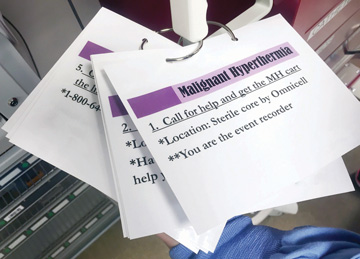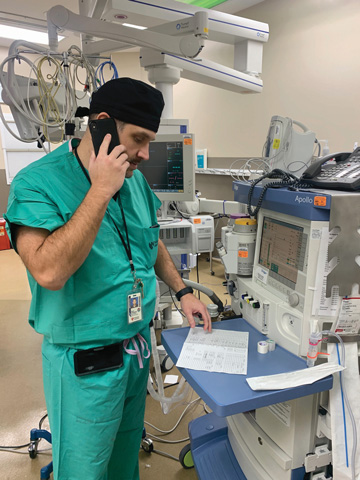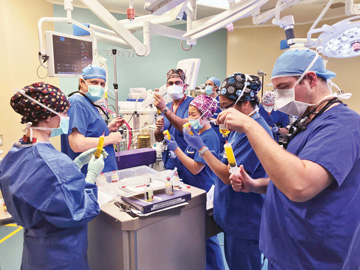2. The element that is responsible for the body's deregulation in an MH crisis is _____________.
- a. calcium
- b. magnesium
- c. sodium
- d. phosphorus
- Reveal
Answer: a
People who have a genetic susceptibility to an MH event can be in immediate danger when they're exposed to a triggering agent, according to the Malignant Hyperthermia Association of the United States (MHAUS).
The genetic mutation causes abnormal proteins to be present in their muscle cells and an MH emergency begins when the triggering agent causes a higher-than-usual release of calcium from the sarcoplasmic reticulum, a storage
site for calcium in muscle cells. "Calcium cannot return to the muscle cell, because the triggering agent is acting like a gatekeeper and blocking it from getting back in. This is why we see patients in MH episodes with sustained
muscle contraction," says Ms. Schwendeman.
In addition to sustained muscle contraction, the calcium deficit in the muscles causes an increase in metabolic rate and severe heat production, which results in a fever. Muscle
cells in this state experience a depletion of adenosine triphosphate, their source of energy, and eventually die and release large volumes of potassium into the blood stream that causes hyperkalemia and cardiac arrythmias.
Eventually, the muscle cells release the myoglobin pigment that can be toxic to the kidneys.
Close
3. Which of the following statements regarding the incidence of MH is true?
- a. Research shows that women and people older than 19 years are less likely to experience an MH emergency.
- b. A genetic carrier will experience an MH crisis every time they are exposed to a triggering agent.
- c. A genetic carrier will never experience an MH emergency if they're not exposed to an anesthetic triggering agent.
- d. Children with one parent who has one of the genetic mutations that make people susceptible to MH have a 50-50 chance of carrying the mutation themselves.
- Reveal
Answer: d
Susceptibility is mainly inherited with an autosomal dominant inheritance pattern, giving a child with a parent who has the mutation a 50% chance of inheriting it. "Men and children might seem to have a slightly
higher rate of clinical symptoms, but an MH incident is equally possible in all sexes, ages, races and nationalities," says Ms. Schwendeman. "If you're a carrier, and you're administered a triggering agent, you could experience
an event."
It's possible for an MH-susceptible patient who undergoes surgery multiple times and is exposed to triggering anesthetic agents to not experience an emergency and still have no idea that they are carriers of
the genetic susceptibility that puts them at increased risk. "Someone could have had three surgeries with no problems but could experience a crisis during the fourth," says Ms. Schwendeman.
Multiple studies show that MH
complications take place in one of 10,000 to 25,000 surgeries, severe morbidity and death can occur in 35% of cases and 11% of MH episodes can be fatal despite treatment.
Close
4. Prophylactic dosing of dantrolene should be administered before surgery when the patient is unsure if the genetic disposition is present.
- a. true
- b. false
- Reveal
Answer: b
Literature on MH does not recommend prophylactic dosing of dantrolene for any patient before surgery. Patients who preoperatively report a personal or family history of MH or who experienced an MH-like event
are considered susceptible, according to Ms. Schwendeman. Preventative measures include reducing or eliminating exposure to volatile gases. These patients should also be scheduled as the first case of the day if possible to
minimize the presence of volatile gases in the OR air from previous surgeries. Other precautions can include removing vaporizers from the anesthesia machines and replacing all disposable equipment, such as the breathing circuit,
reservoir bag, carbon dioxide absorbent, carbon dioxide line and water traps. Also, to further reduce volatile agent concentrations, anesthesia providers should use an activated charcoal filter on each respiratory limb of the
breathing circuit. The anesthesia plan might include other preventive measures per provider preferences.
Close
.svg?sfvrsn=be606e78_3)



.svg?sfvrsn=56b2f850_5)